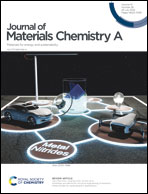Machine learning reveals factors that control ion mobility in anti-perovskite solid electrolytes†
Abstract
Solid-state batteries are projected to exhibit improved energy densities and safety compared to liquid-electrolyte-based systems. Consequently, the development of solid electrolytes that can conduct cations at rates comparable to that of liquid electrolytes is an active area of research. To facilitate this search it is desirable to understand the chemical and structural features that control ion transport through a crystalline lattice. Here, machine learning (ML) is used to identify features that influence ion mobility in solids, quantify the relative importance of those features, and demonstrate how the variation of individual features alters ion mobility. Adopting the anti-perovskite lattice as a model system, ML algorithms were trained to predict migration barriers from a data set containing hundreds of barriers calculated using density functional theory. More than 106 feature sets of non-redundant descriptors were evaluated for their ability to predict migration barriers. The present analysis correctly reiterates the importance of several features that are known to influence mobility – for example, anion polarizability – but also identifies others whose importance is not widely recognized. Lattice properties such as hopping distance and channel width exhibit the greatest influence on cation mobility. Individual conditional expectation analyses performed on these features shows that barriers decrease as hopping distance decreases and as channel width increases. The defect formation energy – which is commonly associated with the concentration of defects, but not with their mobility – is identified as an important feature for interstitial migration. In sum, this analysis aids in the design of optimal solid electrolytes by simplifying the multi-dimensional design space to a sub-set of properties that are the most important.



 Please wait while we load your content...
Please wait while we load your content...